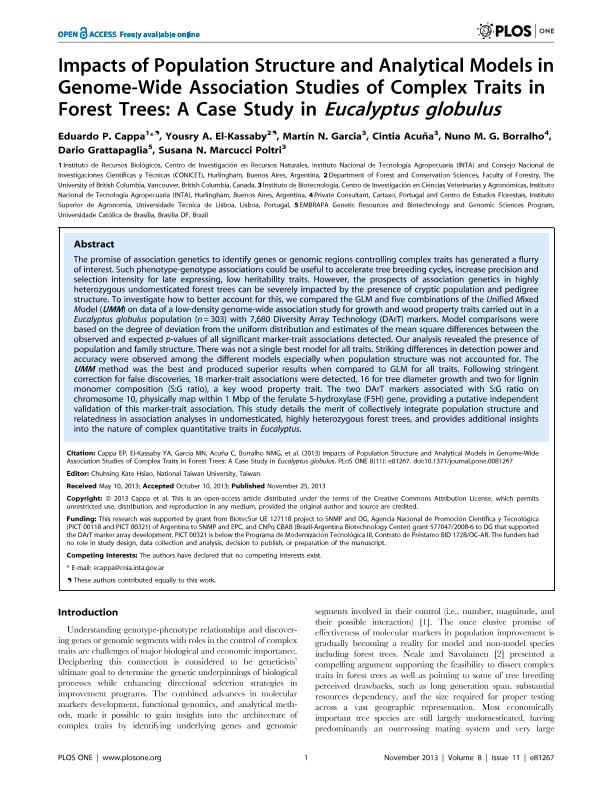Artículo
Impacts of population structure and analytical models in genome-wide association studies of complex traits in forest trees: a case study in Eucalyptus globulus
Cappa, Eduardo Pablo ; El Kassaby, Yousry A.; Garcia, Martín Nahuel
; El Kassaby, Yousry A.; Garcia, Martín Nahuel ; Acuña, Cintia Vanesa
; Acuña, Cintia Vanesa ; Borralho, Nuno M. G.; Grattapaglia, Dario; Marcucci Poltri, Susana Noemí
; Borralho, Nuno M. G.; Grattapaglia, Dario; Marcucci Poltri, Susana Noemí
 ; El Kassaby, Yousry A.; Garcia, Martín Nahuel
; El Kassaby, Yousry A.; Garcia, Martín Nahuel ; Acuña, Cintia Vanesa
; Acuña, Cintia Vanesa ; Borralho, Nuno M. G.; Grattapaglia, Dario; Marcucci Poltri, Susana Noemí
; Borralho, Nuno M. G.; Grattapaglia, Dario; Marcucci Poltri, Susana Noemí
Fecha de publicación:
11/2013
Editorial:
Public Library of Science
Revista:
Plos One
ISSN:
1932-6203
Idioma:
Inglés
Tipo de recurso:
Artículo publicado
Clasificación temática:
Resumen
The promise of association genetics to identify genes or genomic regions controlling complex traits has generated a flurry of interest. Such phenotype-genotype associations could be useful to accelerate tree breeding cycles, increase precision and selection intensity for late expressing, low heritability traits. However, the prospects of association genetics in highly heterozygous undomesticated forest trees can be severely impacted by the presence of cryptic population and pedigree structure. To investigate how to better account for this, we compared the GLM and five combinations of the Unified Mixed Model (UMM) on data of a low-density genome-wide association study for growth and wood property traits carried out in a Eucalyptus globulus population (n = 303) with 7,680 Diversity Array Technology (DArT) markers. Model comparisons were based on the degree of deviation from the uniform distribution and estimates of the mean square differences between the observed and expected p-values of all significant marker-trait associations detected. Our analysis revealed the presence of population and family structure. There was not a single best model for all traits. Striking differences in detection power and accuracy were observed among the different models especially when population structure was not accounted for. The UMM method was the best and produced superior results when compared to GLM for all traits. Following stringent correction for false discoveries, 18 marker-trait associations were detected, 16 for tree diameter growth and two for lignin monomer composition (S∶G ratio), a key wood property trait. The two DArT markers associated with S∶G ratio on chromosome 10, physically map within 1 Mbp of the ferulate 5-hydroxylase (F5H) gene, providing a putative independent validation of this marker-trait association. This study details the merit of collectively integrate population structure and relatedness in association analyses in undomesticated, highly heterozygous forest trees, and provides additional insights into the nature of complex quantitative traits in Eucalyptus.
Archivos asociados
Licencia
Identificadores
Colecciones
Articulos(SEDE CENTRAL)
Articulos de SEDE CENTRAL
Articulos de SEDE CENTRAL
Citación
Cappa, Eduardo Pablo; El Kassaby, Yousry A.; Garcia, Martín Nahuel; Acuña, Cintia Vanesa; Borralho, Nuno M. G.; et al.; Impacts of population structure and analytical models in genome-wide association studies of complex traits in forest trees: a case study in Eucalyptus globulus; Public Library of Science; Plos One; 8; 11; 11-2013; 1-16; e81267
Compartir
Altmétricas



